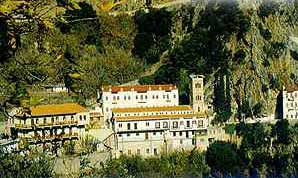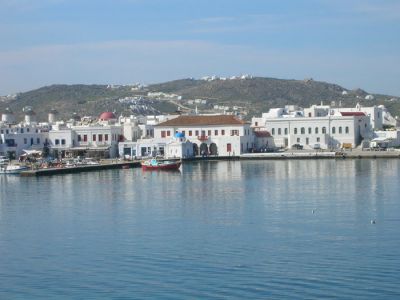|
|
Geography
 Greece lies at the Southeastern tip of Europe, at the
southernmost extremity of the Balkan peninsula. It is a
mountainous, stony country with a highly indented and
crenellated coast. The mailand coastilene is 4,000 km long
while 9,841 islands, 114 of which are inhabited, add another
15,000 km of coastline. The country shares bordes to the north
with Albania, F.Y.R.O.M., Bulgaria and to the east with
Turkey, a total length of 1,228 km. Greece lies at the Southeastern tip of Europe, at the
southernmost extremity of the Balkan peninsula. It is a
mountainous, stony country with a highly indented and
crenellated coast. The mailand coastilene is 4,000 km long
while 9,841 islands, 114 of which are inhabited, add another
15,000 km of coastline. The country shares bordes to the north
with Albania, F.Y.R.O.M., Bulgaria and to the east with
Turkey, a total length of 1,228 km.
Consists of mainland
Greece (Attica,
Peloponnese, Central
Greece, Thessaly, Epirus,
Macedonia, Thrace) and the Islands. Geographically it
belongs to Europe since it forms the most southerly extremity
of the Balkan peninsula but it also has a special link with
Europe through the small entity of the Ionian Islands (Zante,
Ithaca, Corfu, Kefalonia,
Lefkas, Meganisi
and Paxi) which form a
chain off Greece's western shores in the Ionian Sea.
The
Saronic Gulf
which is the stretch of sea linking the shores of
Attica to those of the Peloponnese, contains a further group
of small islands (Salamina, Aegina,
Poros, Hydra
and
Spetses)
which adds its variety to the general surroundings.
There
are the numerous islands of the Aegean Sea, some isolated like
Crete
and Gavdos
(Libyan Sea) to the South, Ikaria, Chios,
Lesvos,
Psara,
Inousses and
Samos
to the East, Limnos,
Thassos
and Samothraki to the North.
 The Cyclades consist of
39 islands, the more important ones being Amorgos, Anafi,
Andros,
Antiparos,
Delos, Ios,
Kea
(also called Tzia), Kimolos,
Kithnos,
Folegandros, Milos,
Mykonos, Naxos,
Paros, Santorini (also called Thera),
Serifos, Sikinos,
Sifnos, Syros,
Tinos,
and the Small East Cyclades, Koufonisia The Cyclades consist of
39 islands, the more important ones being Amorgos, Anafi,
Andros,
Antiparos,
Delos, Ios,
Kea
(also called Tzia), Kimolos,
Kithnos,
Folegandros, Milos,
Mykonos, Naxos,
Paros, Santorini (also called Thera),
Serifos, Sikinos,
Sifnos, Syros,
Tinos,
and the Small East Cyclades, Koufonisia
The Dodecanese
group consists of twelve major islands, Astypalea,
Kalymnos,
Karpathos, Kassos, Kastelorizo
(Megisti), Kos, Lipsi,
Leros, Nisyros,
Patmos, Rhodos, Symi,
and a number of smaller islands, such us Halki
and Tilos, each
with its distinctive features and peculiarities.
The Sporades,
consisting of Alonissos, Skiathos,
Skopelos and
Skyros, lie
of the eastern shores of mainland Greece and retain their
genuine island characteristics and unchanged local traditions.
Variety
is, in fact, the hallmark of the Greek geographical landscape
generally. On the one hand, there are high mountains and
entire mountain ranges such as the Pindos range (also known as
Greece's backbone) or Mount Olympus (with its summit the
Pantheon, the highest peak in Greece at an altitude of 2,917
meters) and the mountains of Macedonia and
Thrace intersected
here and there by a few valleys through which relatively small
rivers flow. On the other hand, the endless lacework of
the coastline produces a series of scenic surprises. It is
these heavily indented shores which give Greece such rare
beauty, quite unique in the Mediterranean. The length of the
Greek coastline is estimated at 15,000 kilometers. The marked
variety of the terrain above water continues under water,
along the seabed which, millions of years ago, formed a
projection of the land. Close to Cape Tainaron, (Tenaro) off
the South tip of the Peloponnese, the so-called Oinousai
(Inousses) Pit is 4,850 meters deep which is the deepest point
in the Mediterranean. Vegetation and climate conform with
the variations in the geographical area. The variety of plants
is exceptional some 6,000 indigenous species having so far
been recorded, 250 of which flourish on the island of Crete.
It is an impressive figure due to Greece's geographical
position between Europe and Africa. Plants associated
with the joys of life are the country's countless vineyards.
Major vegetation is likewise peculiar and above all made to
man's measures. The trees are of medium height and vary from
pine, oak, fir, olive and mulberry trees to fruit and palm
trees. Another result of the country's geographical
location is also seen in its climatic range with mild winters
and sub-tropically warm summers cooled by a system of seasonal
breezes popularly called "meltemia". Lastly, an
outstanding feature of the Greek climate is its ample
sunshine. It is no exaggeration to state the sun shines
in Greece for 3,000 hours per year.
|